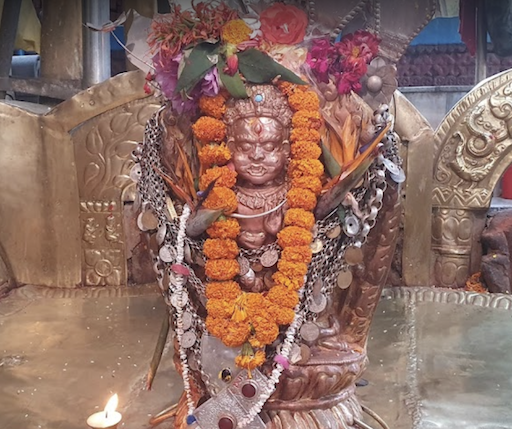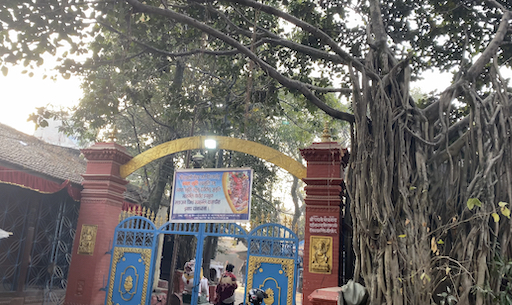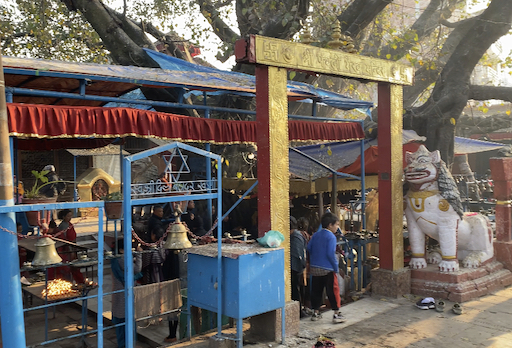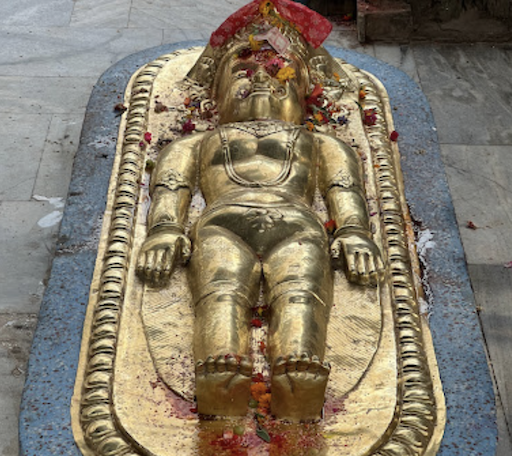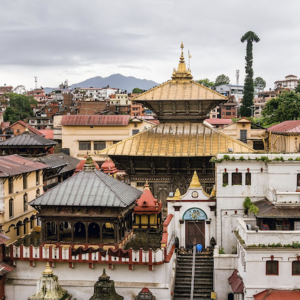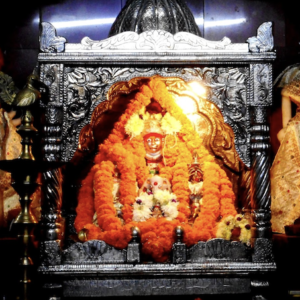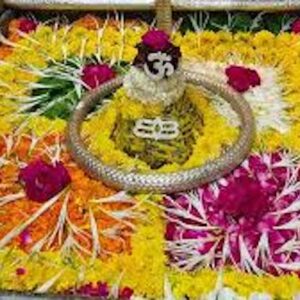This is a consecrated temple of Pachali Bhairav. You can make offerings and go close to the Deity. There is space to sit and meditate. You can go into meditative states effortlessly here.
How to get there
This temple is located at Teku, near the Bagmati River.
Map: https://goo.gl/maps/q3CvVXwTCs8izrd26
About Pachali Bhairav
Pachali Bhairav is another Bhairav mandir in the Kathmandu valley. This one is located in Teku. Pictures of Bhairav can be found in Buddhist religious communities just as in Hindu sanctuaries. Bhairav likewise abides in houses, fields, incineration grounds, wells, road intersections, the four wheels of the chariot of Macchendranath at Patan, etc. Bhairav speaks to pollution, over all the contamination of death. His quality is additionally accepted to have the ability to ensure the region around him.
The majority of the accounts clarify that it was the Thakuri ruler Gunakamadev (924-1008 A.D.) who built up the love of Pachali Bhairav. The god is particularly related – in any event in the Newari creative mind – with the establishing of Kathmandu, since it was King Gunakamadev who is generally accepted to have established both the city and the celebration of Bhairav. He is additionally credited with bringing the Nava Durga (the goddess revered during the celebration of Dahsain) to the Kathmandu Valley, beginning the celebration of Indra Jatra, the Lakhe moves, etc. He likewise initiated, supposedly on the counsel of the god Karttikeya-Skanda, the custom clash – including human penances – that occurred between the north (Yambu) and the south (Yangal) of the town during the celebration of Sithi-nakha, so as to keep his subjects from revolting. The political establishment of the twofold realm was abrogated by 1484, when Ratna Malla made Kathmandu his realm, yet a portion of the related ceremonies and social structures remain. The Kings of Patan were associated with the yearly celebration of Pachali Bhairav and a puja plate is as yet sent in his respect to the sanctuary by their relatives, living in Mangal Bazaar at Patan, who are called Bhairav Malla.
One of the most antiquated sanctuaries of Bhairav in Kathmandu is arranged in the south of the advanced town close Tekudovan at the conversion of the Bagmati and Vishnumati waterways. It is near the incineration ghat on the Bagmati, the Ganga of the Kathmandu Valley. Under the shade of a major pipal tree, on the special stepped area of the open haven, there is a stone speaking to Pachali Bhairav, with encompassing stones that represent his orderlies (gana). Confronting the special stepped area is the betal on which blood penances are performed. In light of the comparability of the Pachali Bhairav stone to the human bottom, individuals originating from the fields of India ridiculed the conciliatory acts of the Newar. So in the seventeenth century, King Pratap Malla secured a large portion of the first token and now just an area of the stone is noticeable.
As indicated by legend, Pachali Bhairav was the lord of Pharping (a town toward the south of Kathmandu), and had the propensity for securing himself a room of his royal residence to eat tremendous amounts of rice and a goat at one sitting. One night, his better half demanded coming and sharing his feast. The ruler acknowledged however educated her that he would have very another appearance, and that she would need to toss a few grains of rice on him so as to reestablish his human viewpoint. At the point when she saw his actual structure, his significant other was so frightened at seeing Bhairav that she fled, neglecting to toss the grains. Scared of being found by his subjects, the uncovered ruler assumed shelter in the position where the sanctuary of Pachali Bhairav stands today. His significant other faltered somewhat further on and became Lumarhi, the perilous goddess Bhadrakali whose sanctuary remains at the edge of the Tundikhel field.
In another rendition, Pachali Bhairav had the propensity for leaving Pharping every morning to wash in the Ganga at Banaras and coming back to Kathmandu as an attractive man. Thusly, he enticed a little youngster of the butcher position (kasai) who tended pigs close to the sanctuary site. (In certain records, he was rather a jyapu [farmer] who in this manner defied the norms of station.) Before long, she excessively got inquisitive and he at last consented to uncover himself, if she tossed a few grains of rice when she saw his genuine character. She also overlooked and fled when she was gone up against by her twisted darling. Bhairav sought after her as the night progressed, however when day started to sunrise he looked to conceal himself. He arrived at an incineration ground and wrapped a bamboo tangle, for example, the Newars use for their dead, around himself. This one had in certainty been accustomed to carry a body to the incineration ghat. He needed more an ideal opportunity to vanish absolutely underground – the stone loved today is his unconcealed butt cheek! Another rendition clarifies the cozy relationship of the Kasai standing with the god Ganesh. The lured butcher young lady got pregnant and her dread at the odd appearance of her darling incited the untimely birth of the youngster, who was received by the Kasai. The youngster is in all honesty Ganesh, who is revered by the butchers of South Kathmandu as a little bronze sculpture appended to a drum that they play during various functions.
There is one more record in which Bhairav was not a lord but rather a rancher: Bhairav strolled with his girl Kumari and his child Ganesh during the celebration of Indra. Bhairav’s better half, Ajima (likewise of Jyapu position) was desirous on the grounds that she was not with them, and asked Bhairav to walk around her around Kathmandu. He concurred, yet not during the Indra Jatra. That is the reason during the Pachali Bhairav celebration, a parade is held where a man picked to wear the veil of Bhairav and someone else wearing the cover of Ajima walk together through Kathmandu. During Indra Jatra, the parade of Kumari the virgin-goddess is in certainty joined by Ganesh and Bhairav, however in this unique situation,
Read More
https://www.nepal-travel-guide.com/pachali-bhairav/
